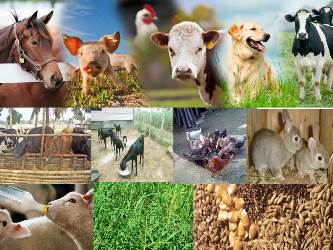



Received: 01-Feb-2022, Manuscript No. GJASLPAB-22-59173; Editor assigned: 03-Feb-2022, Pre QC No. GJASLPAB-22-59173 (PQ); Reviewed: 17-Feb-2022, QC No. GJASLPAB-22-59173; Revised: 21-Feb-2022, Manuscript No. GJASLPAB-22-59173 (R); Published: 28-Feb-2022
For centuries, traditional breeding programs such as breeding, outbreeding or marker-assisted selection introduction have been used to target the characteristics of production and immunity while improving the genetic merit of pets. The advent of new scientific concepts such as cloning and genome engineering has added a new and promising research dimension to existing animal husbandry programs. The development of genome editing technologies, such as transcription activator-like effect nuclei, Zinc finger nuclei, and Clustered Regular Interspaces Short Palindromic Repeats Systems (CRISPR), has transformed genes into, indels, can be made with un-precedented accuracy and precision. Furthermore, it offers the opportunity to intensify the frequency of de-sirable alleles in the animal population by genetically modified individuals much faster than conventional breeding.
Genome editing has demonstrated the ability to revolutionize the accuracy and specificity of modifying genetic targets. These tools can be used to improve productivity, immunity, fertility and production of novel animal specimens. Recently, designer nuclei (Zinc Finger Nuclei (ZFNs), Transcript Activator-Like Effect Nuclei [TALENs], and Clustered Regular Interspersed Short Palindromic Repeats [CRISPR/Cas9] have evolved into more efficient and more advanced genes. ZFNs share the use of FokI nuclei and the need for dimers but use a different protein-DNA identification process. TALEN consists of a modular array of TAL recognition sequences paired with the FokI nucleus. These are arranged in pairs, one for each strand, and act as dimers to form double stranded breaks in specific DNA sequences. It has variants like MegaTAL, which combines the TAL arrays with a site-specific cleavage with a nucleus (mega-nucleus), thereby enhancing the overall uniqueness of the combination. Mega TAL as a technology is still in its infancy, although high cost and complex right now, they may become a turnkey solution in the future. For now, these are best left to those who focus on developing and improving the methodology. ZFNs with no compensation benefits are even more confusing when it comes to usage compared to TALEN.
CRISPR/Cas9 is the latest method to make precise cuts in a gene. It is derived from bacteria and archaea, of which they are part of their viral defense system. The CRISPR/Cas9 system contains CRISPR, which binds to a guide RNA and associated endonucleases (Cas9). Its binding specificity depends on the strength of the RNA-DNA interaction. The main advantage of CRISPR/ Cas9 over TALEN-based technologies is the speed of its production and the very low cost. Over the past 5 years, these editing tools have been used to successfully mediate the production of 300 genetically modified pigs, cattle, sheep and goats. Recent reviews illustrate the potential use of these tools in food animals for agricultural purposes and include detailed descriptions of their mechanics and relative capabilities. Because the goals of genetic improvement programs do not change with new tools; Breeders can use any breeding method (s) if they make the most effective progress towards their breeding goal (s). Genetic modification is more likely to be completed synergically than to replace or severely disrupt traditional breeding programs.
The direct modification of zygotes is beneficial to the next generation due to its direct application. However, not all embryos are modified. Considering the risks associated with cloning, on average fewer embryos are required to modify a specific gene using this ap- proach compared to SCNT. The genes of various animals such as cattle, sheep and pigs were modified by this method. One study showed that TALEN mRNA injection into zygote could produce MSTN genetically modified cattle and sheep. This innovation is crucial to the livestock industry, in a sense that specific genetically modified off-springs can be produced through egg pickup, in vitro fertilization and zygote microinjection (OPU-IVF-ZM). Similarly, the PRNP (prion protein) and BLG genes in cattle have been successfully modified by injecting TALEN reagents directly into the zygote. Two studies have focused on the RELA proto-onco-gene gene in pigs, which has been proposed to play a role in resistance against African swine fever.
They successfully produced only pig embryos, while another study was able to obtain many viable piglets that carry the mutations desired for the RELA gene. In addition, the BMPR/FecB gene was recently inhibited in lambs by injecting CRISPR/Cas9 reagents into the zygote.
Genome editing is a new genetic engineering technology with future application to enhance responses to quantitative features in livestock programs. ZFNs, TALENs, and CRISPR/Cas9, the recently established engineering nuclei, are direct examples of the practical exploitation of genome editing techniques that directly initiate the precise transformation of various animal genes. Genome-edited cattle are different from traditional genetically modified animals because recombinant DNA is not included in the animal genome and, therefore, overcome many questions related to the production of genetically modified animals, thereby increasing the likelihood of its social acceptance. The integration of genome editing with industry standards and reproduction technologies provides a practical approach to developing livestock genetics and breeding.